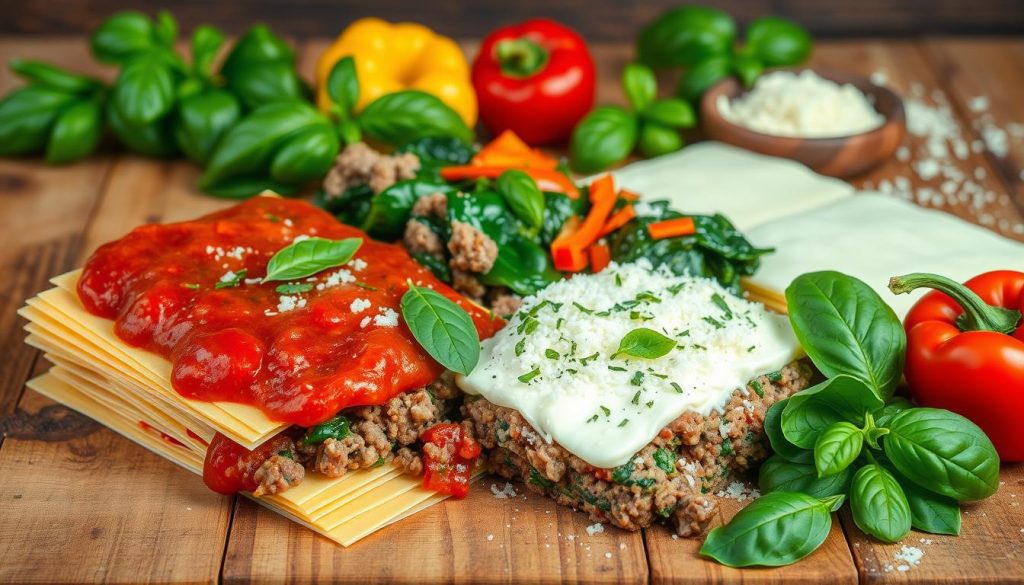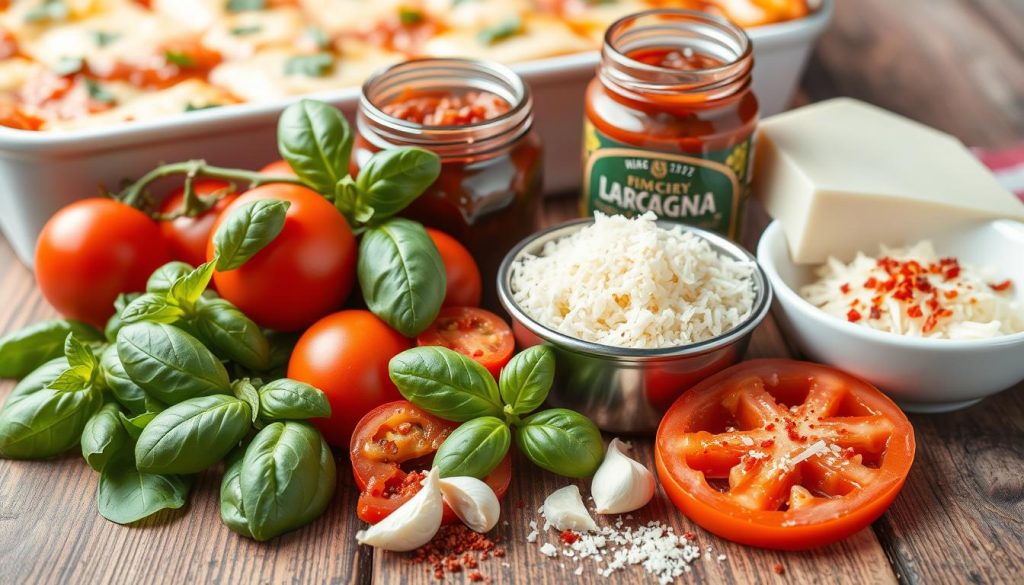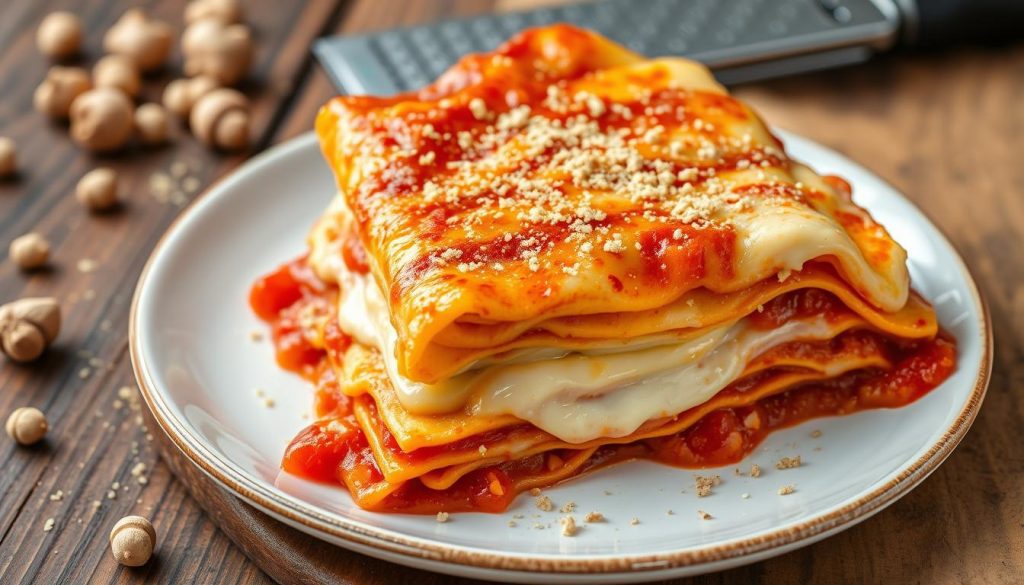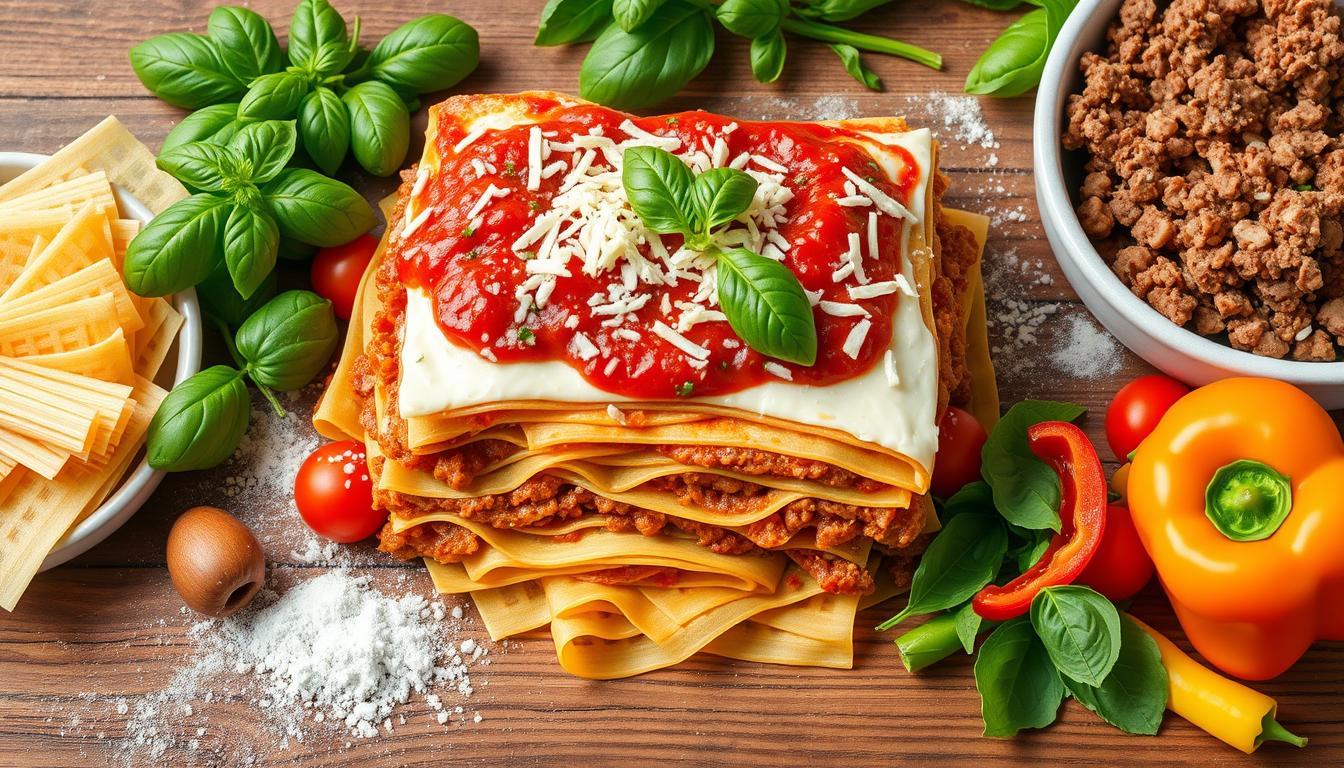I love lasagna and have spent hours perfecting its flavor. If you’ve ever wondered how to achieve better lasagna taste, the secret lies in the details. From choosing the right cheeses to mastering layering techniques, small changes can elevate a simple lasagna into an unforgettable dish.
In this guide, I’ll share tips from professional chefs. They know how to make homemade lasagna taste amazing.
A vibrant flat lay composition of fresh lasagna ingredients, including layers of pasta sheets, rich marinara sauce, creamy ricotta cheese, shredded mozzarella, chopped fresh basil, ground beef, and colorful vegetables like spinach and bell peppers, arranged artfully on a rustic wooden table with a hint of flour dusting the surface.
Main Highlights for Better Lasagna Taste
- Discover the secret ingredient that professional chefs use to make lasagna taste better: nutmeg.
- Learn how small changes to the cheese blend and sauce can significantly enhance the flavor profile.
- Understand the importance of quality ingredients and proper seasoning for a rich, satisfying lasagna.
- Explore expert techniques for layering and assembling your lasagna to achieve restaurant-quality results.
- Uncover the temperature and timing considerations that are crucial for baking the perfect lasagna.
The Secret to Achieve Better Lasagna Taste at Home
Making a delicious homemade lasagna is like art. To truly make lasagna taste better, it’s essential to focus on its key components and use quality ingredients. From the meat sauce to the cheese layers and noodles, every detail matters.
Understanding Basic Lasagna Components for Better Taste
A classic lasagna has key layers. These are a tasty meat sauce, a creamy cheese mix, and cooked lasagna noodles. Together, they make lasagna a favorite comfort food.
The Role of Quality Ingredients in Better Lasagna Taste
Using top-notch ingredients is key for a great lasagna. Choose fresh produce, good meat, and special cheese. The right ingredients can make a big difference.
| Ingredient | Quantity |
|---|---|
| Ground beef chuck | 1 pound |
| Medium onion | 1/2 |
| Large bell pepper | 1/2 |
| Tomato paste | 3 ounces |
| Crushed tomatoes | 1 (14 ounce) can |
Knowing the basics of lasagna and the value of quality ingredients helps. Home chefs can make their lasagna stand out and give a great meal.

A rustic wooden countertop filled with vibrant ingredients for homemade lasagna: layers of fresh pasta sheets, rich marinara sauce, creamy ricotta cheese, freshly grated mozzarella, ground beef mixed with Italian herbs, sautéed spinach, and colorful bell peppers, all arranged artfully with fresh basil leaves and a sprinkle of Parmesan cheese in the background.
Top Tips to Enhance Better Lasagna Taste
Achieving better lasagna taste is simple. With the right ingredients and techniques, you can make every bite amazing. Here are some tips to improve the flavor of your lasagna:
- Nutmeg: This spice adds a warm taste that goes well with lasagna’s cheesy and meaty flavors.
- Fresh Herbs: Basil, oregano, or parsley add a fresh and fragrant touch to your lasagna.
- Quality Cheeses: Use the best ricotta, mozzarella, and Parmesan for a richer cheese layer.
- Balsamic Vinegar: A drizzle of aged balsamic vinegar adds a sweet-tart flavor to the sauce.
- Roasted Vegetables: Adding roasted mushrooms, bell peppers, or zucchini boosts flavor and texture.
Improving lasagna taste is all about trying new ingredients. If you’re wondering how to make lasagna taste better, consider adding unexpected elements like nutmeg or balsamic vinegar. These small changes can elevate your lasagna to restaurant quality.

A vibrant and colorful display of various lasagna flavor enhancers, including fresh basil leaves, grated Parmesan cheese, slices of ripe tomatoes, a jar of marinara sauce, minced garlic, and a sprinkle of red pepper flakes, all beautifully arranged on a rustic wooden table with a partially visible lasagna dish in the background.
The Game-Changing Nutmeg Secret for Better Lasagna Taste
Discover the secret to amazing lasagna flavor with nutmeg. This spice can make your homemade lasagna even better. It adds a special touch that takes it to the next level.
How Much Nutmeg to Add
Adding nutmeg to lasagna is all about balance. Start with 1/8 teaspoon for a 9×13-inch pan. You can adjust it to your liking, but this amount adds a nice warmth without being too strong.
When to Add Nutmeg in the Cooking Process
- It’s best to add nutmeg to the ricotta cheese mixture. Mix it with other seasonings for a flavorful ricotta.
- Using whole nutmeg is more potent. So, you might need less. Watch the amount and adjust as needed.
The secret to great lasagna is finding the right flavor mix. Nutmeg in the ricotta makes it creamier and more complex. Try it and see how nutmeg can change your lasagna game!

A close-up of a delicious lasagna layered with rich, golden cheese, vibrant tomato sauce, and creamy béchamel, sprinkled with finely grated nutmeg, set against a rustic wooden table background with scattered whole nutmeg pods and a microplane grater.
Choosing the Right Cheese Blend to Improve Lasagna Taste
Making a tasty lasagna is all about the right mix of flavors and textures. The cheese blend is key to making your dish stand out. While ricotta and mozzarella are common, other cheeses can elevate your lasagna.
The best cheese for lasagna depends on what you like. A good lasagna cheese blend has creamy ricotta, melty mozzarella, and sharp parmesan. This mix adds a rich, cheese flavor enhancement.
- Ricotta cheese makes the layers stick together.
- Mozzarella cheese gets all gooey and stretchy.
- Parmesan cheese adds a deep, savory flavor.
Trying new cheeses is important to find the perfect lasagna cheese blend. You might like cottage cheese, fontina, or a mix of Italian cheeses. The goal is to balance textures and tastes for a great lasagna.
“The cheese is the heart and soul of a great lasagna. It’s what brings all the flavors together and makes it truly irresistible.” – Chef Giada De Laurentiis
Choosing the best cheese for lasagna is important. Make sure the lasagna cheese blend is spread evenly. This way, every bite will have a great cheese flavor enhancement. With some trial and error, you’ll make a lasagna that everyone will love.
The Great Cheese Debate: Cottage Cheese vs. Ricotta for Better Taste
Choosing the right cheese for lasagna is key. Ricotta is classic, but cottage cheese is a smart choice. It’s creamy like ricotta but has its own benefits.
Benefits of Using Cottage Cheese
Cottage cheese is great for lasagna. It stays creamy, even when hot. This keeps your lasagna layers smooth and together.
It also adds a tangy taste. This taste works well with tomato sauce and meat. It makes the lasagna taste better balanced.
Proper Substitution Ratios
Switching to cottage cheese is easy. Use the same amount as ricotta. So, if a recipe calls for 15 ounces of ricotta, use 15 ounces of cottage cheese.
For creamier cheese, add a bit of heavy cream. About 2-3 tablespoons per 15 ounces of cottage cheese makes it extra rich.
“Cottage cheese is a game-changer in lasagna, providing a creamy texture and tangy flavor that elevates the dish to new heights.”
Mastering the Sauce Layer for Better Lasagna Taste
Making the perfect lasagna is like art. The sauce layer is key for that delicious taste. You can use tomato-based Bolognese or creamy béchamel. The goal is to balance the flavors and seasonings well.
Getting the sauce’s consistency right is important. If it’s too thin, your lasagna might be soggy. If it’s too thick, it could feel heavy. You want it smooth and just right to stick to the noodles.
Don’t hold back on seasoning. Use herbs like garlic, oregano, and basil. Try adding red wine or sugar to balance the tomato’s acidity. This makes your sauce unique.
Layering the sauce is also key. For a classic lasagna, use at least 2 layers. One goes between the noodles, and the other on top. This ensures the noodles soak up the flavors evenly.
Experimenting with ingredients and techniques is the way to master the sauce layer. With practice and passion, you’ll make a lasagna that impresses everyone.
“The secret to a great lasagna is in the layers – the balance of flavors, the texture, and the overall harmony of the dish.” – Chef Giovanni Rossi
Perfecting the Meat Mixture for Better Flavor in Lasagna
Making the perfect meat mixture is key to a great lasagna. You can use ground beef, Italian sausage, or a mix of both. The secret is in the seasoning.
Seasoning Tips for Ground Meat
Seasoning ground meat right is important. Brown the meat in a skillet and break it up. Then, add Italian seasoning, garlic powder, onion powder, and red pepper flakes.
Remember to season with salt and pepper too. This makes sure the meat is tasty before you layer it in your lasagna.
Alternative Protein Options
Ground beef is classic, but you can try other proteins too. Ground turkey or Italian sausage are good choices for a leaner taste. Vegetarians can use tofu or lentils for a meat-free option.
Always adjust the seasoning to match your protein choice. This way, you get the flavor you want in your lasagna.
| Ingredient | Quantity |
|---|---|
| Ground Beef | 1 pound |
| Italian Sausage | 6 ounces |
| Onion Powder | 1 teaspoon |
| Garlic Powder | 1 teaspoon |
| Italian Seasoning | 2 teaspoons |
| Red Pepper Flakes | 1/4 teaspoon |
| Salt and Pepper | to taste |
Essential Herbs and Spices to Enhance Better Lasagna Taste
Improving your homemade lasagna’s taste is about finding the right herbs and spices. The classic Italian mix of basil, oregano, and thyme is key. But, trying new spices can make your dish even better.
Nutmeg is a secret ingredient that can change your lasagna. A little nutmeg adds a warm, nutty flavor. Add it towards the end to keep its scent.
| Herb/Spice | Quantity | Purpose |
|---|---|---|
| Basil | 2 tbsp, fresh | Provides a classic Italian flavor |
| Oregano | 1 tsp, dried | Adds a warm, earthy note |
| Thyme | 1 tsp, dried | Lends a subtle, slightly minty taste |
| Nutmeg | 1/4 tsp, ground | Enhances the overall flavor profile |
Try other lasagna herbs and spices like rosemary, fennel seeds, or red pepper flakes. The goal is to mix flavor enhancing seasonings that match your aromatic lasagna ingredients.
“The secret to a truly exceptional lasagna lies in the careful selection and combination of herbs and spices.”
Professional Tips for Layering and Assembly for Better Taste
Learning to layer and assemble lasagna is key to great taste and texture. As a kitchen expert, I’m happy to share tips to make your lasagna amazing.
Creating the Perfect Layer Structure
The secret to a great lasagna is layer order. Start with a thin meat sauce layer at the bottom. This is the base.
Then, put down a layer of cooked lasagna noodles. Next, add a layer of creamy cottage cheese or ricotta. Finish with mozzarella cheese for even coverage.
Keep layering in this order until you reach the top. End with noodles and mozzarella for a golden, bubbly top.
Temperature and Timing Considerations
Getting the right texture needs careful temperature and timing. Cool your meat sauce and cheese a bit before assembling. This stops noodles from getting soggy and cheese from melting too fast.
Preheat your oven to 350°F (175°C). Bake for 20-30 minutes until the cheese is melted and edges bubbly. Let it rest for 10-15 minutes before slicing. This lets the flavors mix well.
| Lasagna Layering Technique | Time and Temperature |
|---|---|
| Spread thin layer of meat sauce on bottom of dish | – |
| Arrange single layer of cooked lasagna noodles | – |
| Add generous spread of creamy cheese mixture | – |
| Top with layer of grated mozzarella cheese | – |
| Repeat layering process until dish is full | – |
| Bake lasagna at 350°F (175°C) | 20-30 minutes |
| Let lasagna rest before serving | 10-15 minutes |
Follow these tips for amazing lasagna. Your family and friends will love it. You’ll get praise for your lasagna layering techniques, assembling lasagna like a pro, and perfecting the lasagna structure.
The Art of Baking and Resting Your Lasagna for Better Taste
Making the perfect lasagna is more than just putting it together. It’s about baking and resting it right. Knowing the best oven temperature and baking times for different pans is key.
The recipe for 8 people needs to be baked at 375°F (190°C). Start by covering it with foil and baking for 30 minutes. This helps the layers blend and flavors grow.
Then, remove the foil and bake for another 30 to 40 minutes. This makes the top golden and the edges crispy.
After baking, let the lasagna rest for 15 to 20 minutes before serving. This step lets the layers set and the lasagna cool. It makes cutting and serving easier and prevents the layers from falling apart.
By following these steps, you’ll learn how to make lasagna taste better. With crispy edges and a creamy center, this lasagna recipe will make every mealtime special and memorable.
FAQ
What are the basic components of a traditional lasagna?
A traditional lasagna has ricotta or béchamel, a meat sauce, and pasta layers. Each part adds to the dish’s taste and feel.
How can I enhance the flavor of my homemade lasagna?
To make your lasagna taste better, use top-notch ingredients. Try new herbs and spices. Even adding chocolate or vinegar can surprise your taste buds.
What is the secret ingredient that professional chefs use to make lasagna taste better?
Chefs add nutmeg to their lasagna for extra flavor. It’s best mixed into the ricotta. Nutmeg adds a warm, nutty taste that goes well with other ingredients.
What is the difference between using ricotta and cottage cheese in lasagna?
Cottage cheese is a good ricotta substitute. It stays creamy even when hot. This makes it better for lasagna than ricotta, which can curdle.
How can I create a flavorful meat mixture for my lasagna?
Season the ground meat with herbs like basil, oregano, and thyme. Try using ground turkey or Italian sausage for a twist.
What is the best way to layer and assemble my lasagna?
Layer your lasagna in the right order for flavor and structure. Cool hot ingredients before assembling. This helps your lasagna turn out great.
How should I bake and rest my lasagna for the best texture?
Bake your lasagna at the right temperature and time. Consider your pan’s size. Let it rest before serving. This improves the texture and makes it easier to cut.

